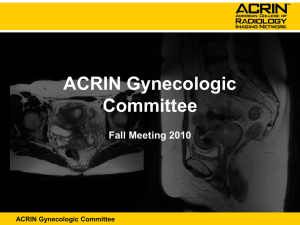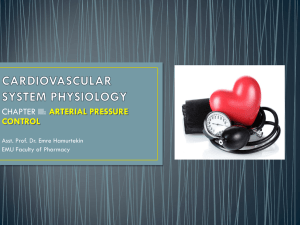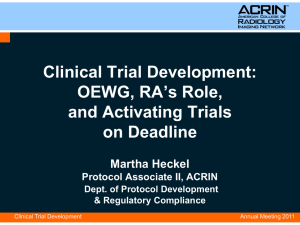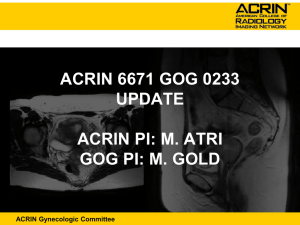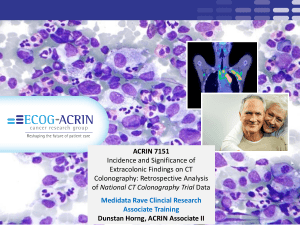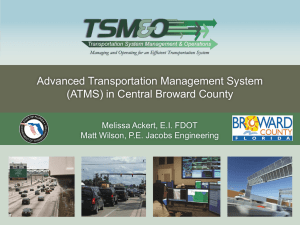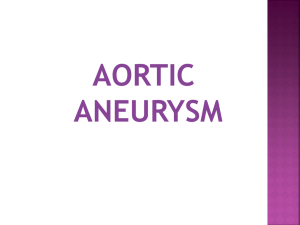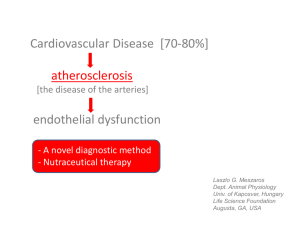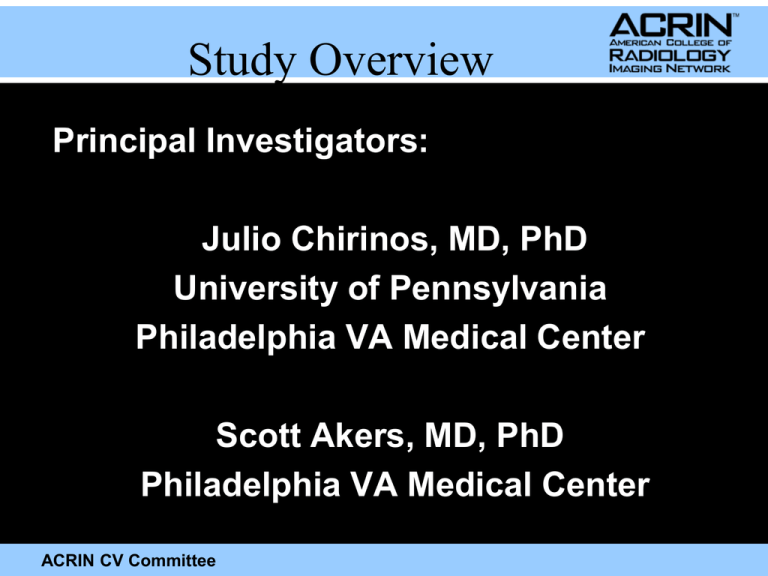
Study Overview
Principal Investigators:
Julio Chirinos, MD, PhD
University of Pennsylvania
Philadelphia VA Medical Center
Scott Akers, MD, PhD
Philadelphia VA Medical Center
ACRIN CV Committee
Background
Calcific aortic stenosis is a disease of the
elderly, which occurs in conjunction with agerelated arterial stiffening and a consequent
increase in pulsatile LV afterload.
Recently, it has been shown that the severity of
aortic stenosis is not correlated with the degree
of LVH assessed with MRI in patients with aortic
stenosis, indicating that additional factors play
an important role in this regard.
Regression of maldaptive LV remodeling postAVR is variable
Dweck MR. J Cardiovasc Magn Reson. 2012;14:50
ACRIN CV Committee
LV Afterload
(“Pressure overload”)
• Important cause for LVH and LV
failure.
• In the absence of aortic stenosis,
LV afterload depends entirely on
the properties of the arterial tree.
Gardin JM et al. Hypertension. 1997;29(5):1095-1103.
Chirinos JA, Segers P. Hypertension 2010; 56(4):555-62.
Bramwell Hill
Equation
Moens–Korteweg
Equation
A
D1
D2
B
LV Afterload
(“Pressure overload”)
• Important cause for LVH and LV
failure.
• In the absence of aortic stenosis,
LV afterload depends entirely on
the properties of the arterial tree.
Gardin JM et al. Hypertension. 1997;29(5):1095-1103.
Chirinos JA, Segers P. Hypertension 2010; 56(4):555-62.
Afterload = Blood Pressure
Afterload = Blood Pressure
Afterload = Blood Pressure
Vs.
Blood Flow
Afterload = Blood Pressure
Vs.
Blood Flow
Patients with identical BP can have very
different afterload patterns.
Afterload = Blood Pressure
Vs.
Blood Flow
• Complex
• “Steady” and Pulsatile components
• Time-varying (time-resolved pressure and
flow)
Pressure: Carotid Tonometry
Aortic flow measurements
Chirinos JA, Segers P. Hypertension 2010; 56(4):555-62.
Pressure-Flow analyses
Arterial determinants of the Central Pressure Profile
300
Zc
TAC
Reflection timing
Reflection
timing
240
90
80
180
70
120
SVR
60
60
50
0
0
0.2
0.4
0.6
0.8
1
Reflection
Magnitude
RM
Flow (mm3/sec )
Pressure
(mmHg)
(mmHg)
Pressure
100
Time (seconds)
SVR
Chirinos JA, Segers P. Hypertension 2010; 56(4):555-62.
Chirinos JA, Segers P. Hypertension. 2010 56(4):563-70.
Effect of Early versus Late Pressure Overload in Rats
Kobayashi S. Circulation. 1996;94:3362-3368.
0.035
Cumulative Hazard for
First Heart Failure Event
0.030
Log-rank χ2 = 19.24
P < 0.0001
0.025
Top tertile
Middle tertile
Bottom tertile
0.020
0.015
0.010
0.005
0
0
2
4
6
8
Time to Heart Failure or Last Follow-up (Years)
Chirinos JA et al. J Am Coll Cardiol 2012.
Cumulative Hazard for
First Heart Failure Event
0.030
0.025
HTN
/ High RM
No HTN / High RM
HTN
/ Low RM
No HTN / Low RM
0.020
0.015
0.010
0.005
0
0
2
4
6
8
Time to Heart Failure or Last Follow-up (Years)
Chirinos JA et al.
J Am Coll Cardiol 2012.
HTN
No
Yes
No
Yes
High RM
No
No
Yes
Yes
Hazard Ratio (95% CI)
-------1.81 (0.85-3.86)
2.16 (1.06-4.43)
3.98 (1.96-8.05)
P value
------0.12
0.03
<0.0001
Predictors of incident heart failure in multivariate
analysis (n=5932)
Chirinos JA, Kips J, Jacobs D et al. JACC 2012.
Pusatile load and wave reflections
cause maladaptive LV remodeling and
hypertrophy and represent an
important novel predictor of HF risk in
the general population.
Is it important in the setting of AS?
Primary Aim
To test the hypothesis that increased
stiffness of the aortic wall and arterial
wave reflections correlate with an
adequate regression (improvement) of LV
hypertrophy and LV myocardial fibrosis
measured with cardiac MRI after AVR for
severe aortic stenosis.
ACRIN CV Committee
Secondary Aims
To test the hypothesis that myocardial T1rho mapping, a noncontrast myocardial tissue characterization MRI technique,
correlates with LV myocardial fibrosis assessed with postgadolinium myocardial T1 measurements in participants with
severe aortic stenosis.
To test the hypothesis that changes in myocardial T1rho after
AVR in participants with severe aortic stenosis correlates with
changes in LV myocardial fibrosis assessed with postgadolinium myocardial T1 measurements.
To test the hypothesis that increased stiffness of the aortic
wall and arterial wave reflections correlate with physical
fitness (assessed via a 6-minute walk test) after AVR for
severe aortic stenosis
ACRIN CV Committee
Inclusion Criteria
18 years of age or older;
Severe symptomatic aortic stenosis (estimated aortic valve area <1
cm2) 1,2
Planned for AVR between 0 and 28 days after enrollment;
Able to have a cardiac MRI between 7 and 28 days after enrollment
(the 21 days before the AVR operation);
A preoperative coronary angiography demonstrating the absence of
hemodynamically-significant CAD in need of revascularization
during AVR;
Able to tolerate cardiac MR imaging with gadolinium contrast as
required by protocol, to be performed at an ACRIN-qualified facility
and scanner;
Willing and able to provide a written informed consent.
ACRIN CV Committee
Exclusion Criteria
Not suitable to undergo cardiac MRI or gadolinium contrast administration
(Claustrophobia, presence of metallic objects or implanted medical devices,
etc)
Known allergy to contrast media
Weight greater than that allowable by the MRI table;
LV ejection fraction <50%;
Previous aortic valve surgery
Planned additional (non-aortic) valve repair/replacement
Infective endocarditis;
> Mild Aortic Insufficiency
Rhythm other than sinus rhythm
Presence of hemodynamically-significant CAD
Myocardial infarction or unstable angina in the previous month;
ACRIN CV Committee
Exclusion Criteria
Pre-operative estimated glomerular filtration rate (eGFR) <40
mL/min/1.73m2 of body surface area.
An eGFR < 30 mL/min/1.73m2 of body surface area or acute kidney injury
willl be a contrainidcation for gadolinium contrast administration at any time
during the study.
Presence of a bicuspid aortic valve;
Resting heart rate >120 beats per minute, systolic blood pressure >180 mm
Hg,
or diastolic blood pressure > 100 mm Hg;
Pregnancy.
Unwillingness to undergo a cardiac MRI;
Unwillingness to sign the consent form.
Life expectancy < 1 year
ACRIN CV Committee
Participating Sites
Hospital of the University of
Pennsylvania
Investigator(s):
Julio Chirinos, MD, PhD
Research Associate:
Preston Broderick
University of Pittsburgh
Investigator(s):
Joao Cavalcante, MD
Research Associate:
Lisa Baxendell
ACRIN CV Committee
Philadelphia VA Medical Center
Investigator(s):
Scott Akers, MD, PhD
Research Associate:
Preston Broderick
Penn State – Milton S. Hershey
Medical Center
Investigator(s):
Carlos Jamis-Dow, MD
Research Associate:
Swati M. Shah
General overview
ACRIN CV Committee
Study Table Procedure
Informed Consent Form
Eligibility Review
Pregnancy Assessment for Women of
Childbearing Potential
(Per General Practice and Institution’s SOC)
eGFR Assessment of Renal Sufficiency (Prior
to Enrollment and Each Cardiac MRI Scan)
BASELINE VISIT 2/
MRI SCAN 1:
Cardiac MRI Within 3 Weeks Prior
to AVR
X
X
X
X
Collect Data on Symptoms
Participant Self-Completes
QoL Questionnaire
Kansas City Cardiomyopathy Questionnaire
X
ACRIN Web Registration
Schedule Cardiac MRI for Within
the 3 Weeks Prior to AVR
Pre-MRI Medication Review
(Confirm usual use of vasoactive medications.
Ensure no short-acting nitrates have been used
within 4 hours prior to the MRI [or reschedule].)
X
X
X
X
Intravenous Catheter Placement
MultiHance® Contrast Agent Administration
(0.15 mmol/kg body weight)
X
Study Cardiac MRI
Arterial Tonometry Examination
Blood Collection and Storage
6-Minute Walk Test
(See Appendix III)
AE Assessment: Follow Up by Telephone 24 to
72 Hours after Each Cardiac MRI Scan
X
X
X
ACRIN CV Committee
X
6-MONTH VISIT 3/
MRI SCAN 2:
Cardiac MRI 6 Months
(± 2 Weeks) After AVR
AVR Procedure per Institutional Standard Practice
Within 8 Weeks After Enrollment
Study Procedure
VISIT 1:
Eligibility/
Registration
X
X
X
X
X
X
X
X
X
X
X
X
X
X
VISIT 1: Eligibility/Registration
ICF
Eligibility
Medical History
eGFR within last 4 weeks
Review results of preop coronary angiogram
Exclude pregnancy
ECG within 8 weeks (NSR)
Data collection
KCCQ
Resgistration and Scheduling of baseline MRI
ACRIN CV Committee
VISIT 2: Pre-AVR MRI
Recheck eGFR unless available within 4 weeks
Exclude pregnancy as per instutional standard
of care
No smoking, ETOH or food for 4 hours or
caffeine for at least 24 hours.
No nitrates for at least 4 hours
Usual medications
Blood draw (3 tubes: plasma, serum, htc). Store
serum and plasma samples at -80 C in 0.5 mL
vials.
ACRIN CV Committee
VISIT 2: Pre-AVR MRI
IV line for Gad
Perform Cardiac MRI
Perform arterial tonometry
Phone interview 72 hours after visit for AEs
ACRIN CV Committee
VISIT 3: 6 months post-AVR
KCCQ
eGFR check within 4 weeks (may require blood
draw specifically for this purpose)
Exclude pregnancy
No smoking, ETOH or food for 4 hours or
caffeine for at least 24 hours.
No nitrates for at least 4 hours
Usual medications
Blood draw (3 tubes: plasma, serum, htc). Store
serum and plasma samples at -80 C in 0.5 mL
vials.
ACRIN CV Committee
VISIT 3: 6 months post-AVR
IV line for Gad
Perform Cardiac MRI
Perform arterial tonometry
6-minute walk test
Phone interview 72 hours after visit for AEs
ACRIN CV Committee
Arterial tonometry (Preston Broderick)
ACRIN CV Committee
Arterial Tonometry
Preston Broderick, MA
University of Pennsylvania
ACRIN CV Committee
Arterial Tonometry
Non-invasive device used to obtain Pulse
Wave Analysis (PWA), Pulse Wave Velocity
(PWV)
To be performed immediately after the MRI
~30 minute procedure
Participant must be laying down
Do not include PHI in the database
ACRIN CV Committee
Arterial Tonometry
Adding a subject to the database
ACRIN CV Committee
Arterial Tonometry
Information that must be entered
ID
First Initial
Last Initial
Year of Birth
Sex
ACRIN CV Committee
Arterial Tonometry
ACRIN CV Committee
Arterial Tonometry
Pulse Wave Analysis
Obtain BP measurements using an Omron HEM-907
device
Use that data to calculate the mean arterial pressure
with the following equation:
• MAP = DBP + 0.4 (SBP-DBP)
Type the sbp in the notes section as “SBP: x”
Indicate which side the radial tonometry is being
performed in the notes section
Enter data into PWA subject screen as follows
ACRIN CV Committee
Arterial Tonometry
Pulse Wave Analysis (Radial)
ACRIN CV Committee
Arterial Tonometry
Data acquisition
Relax your arms and hands
Maintain a constant pressure
Acquire 12 seconds of data
Complete acquisition by pressing the space bar
Goal is to achieve good consistency and height in the
waveforms
Shoot for as high an operating index as possible
• Ideal target: >90 for radial
• Ideal target: >80 for carotid
ACRIN CV Committee
Arterial Tonometry
12 Seconds of consistent data acquisition
ACRIN CV Committee
Arterial Tonometry
Favorable Result: 94 Operator Index
ACRIN CV Committee
Arterial Tonometry
Unfavorable Result: 0 Operator Index
ACRIN CV Committee
Arterial Tonometry
Pulse Wave Analysis (Carotid)
ACRIN CV Committee
Arterial Tonometry
Pulse Wave Analysis (Carotid)
ACRIN CV Committee
Arterial Tonometry
12 Seconds of consistent data acquisition
ACRIN CV Committee
Arterial Tonometry
Favorable Result: 95 Operator Index
ACRIN CV Committee
Arterial Tonometry
Unfavorable Result: 5 Operator Index
ACRIN CV Committee
Arterial Tonometry
Pulse Wave Velocity
Measure distance (mm) between carotid artery and sternal
notch
Measure distance (mm) between femoral artery and sternal
notch
Shoot for lowest standard deviation possible
• Ideal target <10% SD
Place ECG electrodes on subject prior to acquisition
ACRIN CV Committee
Arterial Tonometry
Pulse Wave Velocity
ACRIN CV Committee
Arterial Tonometry
Pulse Wave Velocity (Carotid)
12 Seconds of consistent data acquisition
ACRIN CV Committee
Arterial Tonometry
Pulse Wave Velocity
ACRIN CV Committee
Arterial Tonometry
Pulse Wave Velocity (Femoral)
12 Seconds of consistent data acquisition
ACRIN CV Committee
Arterial Tonometry
Favorable Result: 7% SD
ACRIN CV Committee
Arterial Tonometry
Unfavorable Result: 13% SD
ACRIN CV Committee
Arterial Tonometry
Exporting data from software
This is the data that will be used for analysis
Export text file after each study visit
Three exports for each visit
• PWA Radial
• PWA Carotid
• PWV
Choose result with highest operator index to export
Keep organized by subject ID, visit number, and result
• 001_B_PWAR
• 001_B_PWAC
• 001_F_PWV
ACRIN CV Committee
Arterial Tonometry
Data Export
ACRIN CV Committee
Arterial Tonometry
Data Export
ACRIN CV Committee
Arterial Tonometry
Data Export
ACRIN CV Committee
Arterial Tonometry
Data Export
ACRIN CV Committee
Arterial Tonometry
Backing up the database
Imperative in case of data loss
Backup text files as well as database file
Database file located in following location:
C:\Program Files\AtCor\SphygmoCor CvMS\data
Filename: scor.xyz
Simply copy/paste file into a location other than C:\ drive
Backup database as frequently as possible
Rename database file to date it was backed up
Example: scor4008_5-23-2013.xyz
ACRIN CV Committee


